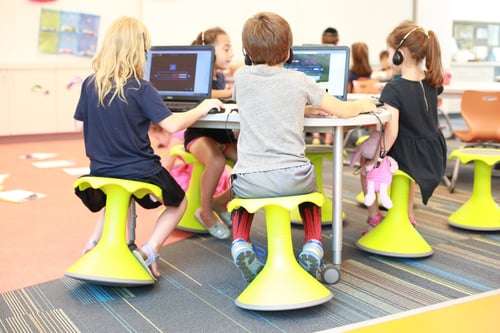Mobile Learning for 21st Century Schools
Fri, Jan 22, 2016 Kate Mraw educational design, K-12 Schools, 21st century schools, Kate Mraw, Student-Centered Design, Samueli Academy
 Digital natives—those born into today’s high-tech, 21st century environment—require an engaging curriculum to match their diverse learning styles and the digital tools used to share knowledge and information. Educational design and planning must support not only mobile devices, but mobile students. Whether it’s the device or the student, connectivity counts. Here are five tips to promote mobile learning in the classroom:
Digital natives—those born into today’s high-tech, 21st century environment—require an engaging curriculum to match their diverse learning styles and the digital tools used to share knowledge and information. Educational design and planning must support not only mobile devices, but mobile students. Whether it’s the device or the student, connectivity counts. Here are five tips to promote mobile learning in the classroom:
Technology is a Moving Target
Accept the fact that technology will change and improve. Plan for the unexpected and when in doubt—it’s all about the power. Additionally, don’t underestimate the power of writable surfaces. In a digital and high-definition age, dry erase boards give students the ability to multitask and quickly collaborate with peers.
+ Goal: Create 100% student-centered design, with every surface a learning opportunity.
Furniture is More Important Than Ever
Embrace the caster. Furniture should be flexible, movable, convertible and writable. A flexible learning environment requires more than mobile desks and chairs—agility allows for the most personalization and flexibility for educational opportunities.
+ Goal: Maximize flexibility and agility for both new construction and renovation of existing spaces.
Blended Learning Personalizes Experiences
The trends framing educational design already surround us in schools across the world, and will shape the conversation for design in the coming decade. Content delivered with a blend of direct instruction and online media gives students more control over the time, place, path and pace at which they learn.
+ Goal: Individualize education plans for all students, not just those with special or advanced needs.
Shift Your Mindset and Flip Your Classroom
In a “flipped classroom,” students spend the time at school engaged in working together, working on problem solving and critical-thinking skills, which are more collaborative and actively engaging. After-school time is used for the content delivery, ‘lecture’ or instruction. Think of how much this educational delivery would influence the design of learning environments.
+ Goal: Increase opportunities for project-based learning, collaboration and critical thinking.
There’s A Code For That
Computer science is not a core subject or a graduation requirement in many curricula. However, this skill must be filled because of both the interest and the opportunity gap. Duke University Professor Cathy Davidson argued in 2012 that computational thinking—if not programming specifically—is the fourth “R,” joining “reading, writing and arithmetic” as the basic skills that everyone should have in the 21st century. (In her formulation, the fourth “R” stands for ‘rithms, as in algorithms.)
+ Goal: Encourage students to excel past the minimum requirements, to become skilled in the language of code from an early age.
Whether it’s a classroom or a curriculum you’re designing, remember this: Learning happens everywhere. Therefore, mobility is key in helping digital natives thrive. Leave us a comment with at least one tip you will start applying today.
Cover photo courtesy of Tom Keene/LAdigitalPhoto.
Kate Mraw is an Associate at LPA Inc. Her design for K-12 schools encourages collaboration, experimentation, and innovation. Mraw is a LEED Accredited Professional and received her Bachelor of Science in Interior Design from the University of Texas, Austin School of Architecture.
